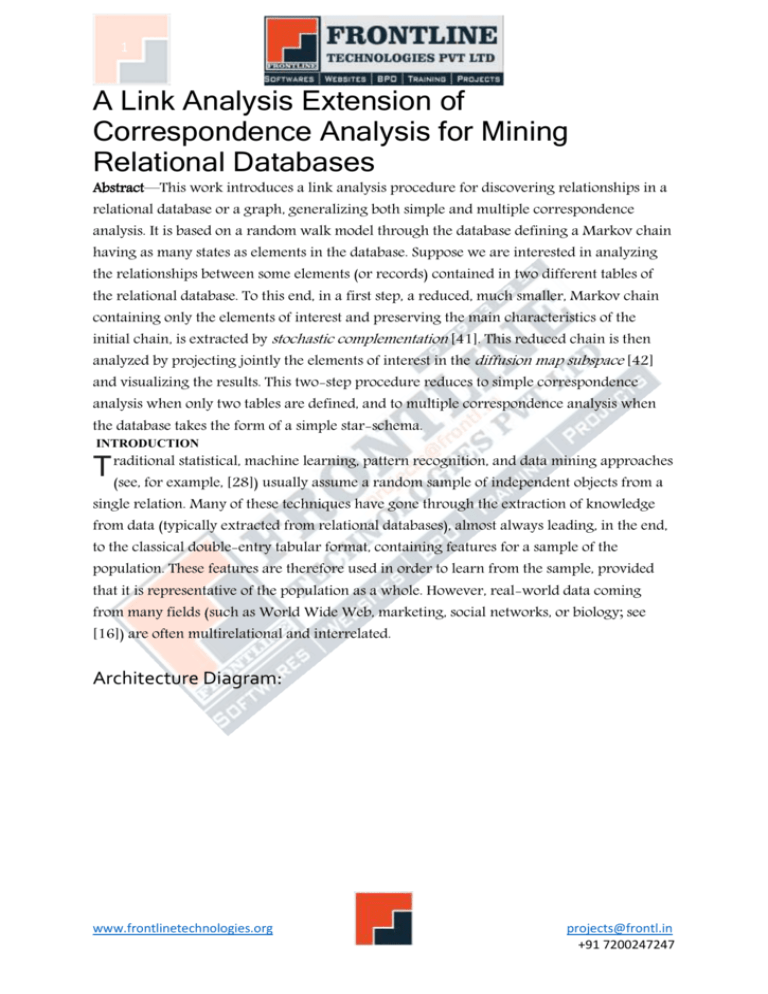A Link Analysis Extension of Correspondence Analysis for Mining
advertisement

1 A Link Analysis Extension of Correspondence Analysis for Mining Relational Databases Abstract—This work introduces a link analysis procedure for discovering relationships in a relational database or a graph, generalizing both simple and multiple correspondence analysis. It is based on a random walk model through the database defining a Markov chain having as many states as elements in the database. Suppose we are interested in analyzing the relationships between some elements (or records) contained in two different tables of the relational database. To this end, in a first step, a reduced, much smaller, Markov chain containing only the elements of interest and preserving the main characteristics of the initial chain, is extracted by stochastic complementation [41]. This reduced chain is then analyzed by projecting jointly the elements of interest in the diffusion map subspace [42] and visualizing the results. This two-step procedure reduces to simple correspondence analysis when only two tables are defined, and to multiple correspondence analysis when the database takes the form of a simple star-schema. INTRODUCTION statistical, machine learning, pattern recognition, and data mining approaches T raditional (see, for example, [28]) usually assume a random sample of independent objects from a single relation. Many of these techniques have gone through the extraction of knowledge from data (typically extracted from relational databases), almost always leading, in the end, to the classical double-entry tabular format, containing features for a sample of the population. These features are therefore used in order to learn from the sample, provided that it is representative of the population as a whole. However, real-world data coming from many fields (such as World Wide Web, marketing, social networks, or biology; see [16]) are often multirelational and interrelated. Architecture Diagram: www.frontlinetechnologies.org projects@frontl.in +91 7200247247 2 CONCLUSION This work introduced a link-analysis-based technique allowing to analyze relationships existing in relational databases. The database is viewed as a graph, where the nodes correspond to the elements contained in the tables and the links correspond to the relations between the tables. A two-step procedure is defined for analyzing the relationships between elements of interest contained in a table, or a subset of tables. More precisely, this work 1) proposes to use stochastic complementation for extracting a subgraph containing the elements of interest from the original graph and 2) introduces a kernel-based extension of the basic diffusion map for displaying and analyzing the reduced subgraph. It is shown that the resulting method is closely related to correspondence analysis. REFERENCES 1. P. Baldi, P. Frasconi, and P. Smyth, Modeling the Internet and the Web: Probabilistic Methods and Algorithms. John Wiley & Sons, 2003. 2. M. Belkin and P. Niyogi, "Laplacian Eigenmaps and Spectral Techniques for Embedding and Clustering," Advances in Neural Information Processing Systems, vol. 14, pp. 585-591, MIT Press, 2001. 3. M. Belkin and P. Niyogi, "Laplacian Eigenmaps for Dimensionality Reduction and Data Representation," Neural Computation, vol. 15, pp. 1373-1396, 2003. 4. C. Blake, E. Keogh, and C. Merz, "UCI Repository of Machine Learning Databases," Univ. California, Dept. of Information and Computer Science, http://www.ics.uci.edu/~mlearn/ MLRepository.html, 1998. www.frontlinetechnologies.org projects@frontl.in +91 7200247247 3 5. J. Blasius, M. Greenacre, P. Groenen, and M. van de Velden, "Special Issue on Correspondence Analysis and Related Methods," Computational Statistics and Data 6. Analysis, vol. 53, no. 8, pp. 3103-3106, 2009. I. Borg and P. Groenen, Modern Multidimensional Scaling: Theory and Applications. Springer, 1997. 7. P. Bremaud, Markov Chains: Gibbs Fields, Monte Carlo Simulation, and Queues. Springer-Verlag, 1999. 8. 9. P. Carrington, J. Scott, and S. Wasserman, Models and Methods in Social Network Analysis. Cambridge Univ. Press, 2006. S. Chakrabarti, Mining the Web: Discovering Knowledge from Hypertext Data. Elsevier Science, 2003. 10. F.R. Chung, Spectral Graph Theory. Am. Math. Soc., 1997. www.frontlinetechnologies.org projects@frontl.in +91 7200247247








